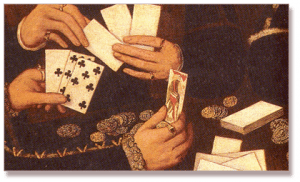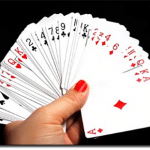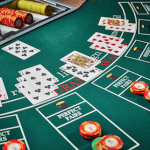Despite blackjack being the most popular casino card game in the world, you’d be hard-pressed to provide a 100% accurate summary of where the game originated from. Many modern texts, gambling scholars and other historians surmise blackjack’s beginnings as ‘uncertain.’
Pinpointing the exact origins of 21 has proven to be an arduous task, and there have been many arguments over when and where the game truly began. To this day, debates still persist as to which country should be credited for blackjack’s creation, or what other card games shaped the modern-day blackjack we know and love today. One thing’s for certain though: what we do know is vastly interesting.
The first traces of the game of 21 are mid-way through the 15th Century, during the dawn of the Western printing press from German printer Johannes Gutenberg in 1450. Prior to its introduction, playing cards was limited to the nobility and upper-class of Europe, and the cards were hand painted by renowned artists and calligraphers. The cards were often not even used for recreation, and instead held an educational or religious purpose. When mass production of cards eventually became prevalent, so too did their affordability. Soon, people from all class systems were able to acquire a deck of cards and play their own games.
The first few card games were largely based on each individual card’s rank, which eventually spawned what we know as the modern-day Casino War in several establishments. But with all card games come parameters, and every game always had a way to determine a winner whether through sequence, suit or rank; and a few French and Spanish card players spawned something much more complex.
The beginnings of blackjack
The earliest record of a game called blackjack or “twenty one” was referenced in literature in the early 1600s by Miguel de Cervantes, the famous Spanish author known for Don Quixote. The book in question, Ronconete y Cortadillo mentions a game called ‘Veintiuna’ in de Cervantes’s story, which is Spanish for twenty-one.
In his story, the main characters are proficient at cheating at Veintiuna. De Cervantes notes it is a card game played with a Spanish baraja deck, where the Eights, Nines and Tens are removed, and Aces are worth either one or 11 points. This rule set bears a striking resemblance with the modern-day blackjack variant, Spanish 21. Many more references to Veintiuna were found in later books from both Spain and France, but de Cervantes’s is the earliest written reference.
The first known and recorded emergence of blackjack actually being played is credited to French casinos around the year 1700. The game of blackjack was then known under the name of Vingt-et-Un which, translated, also means 21. Historians believe Vingt-et-Un derived from then-popular French card games, Chemin de Fer (Iron Way) and French Ferme (Firm French), both of which were considered in fashion at the time. However, rules were vastly different in this early version of blackjack: the dealer was apparently the only party who could double down, and more betting rounds were available throughout each hand.
Vingt-et-Un proved quite popular and it didn’t take long for it to spread outside of French casinos into private games across the country. Soon, with the New World on many minds, several French colonists brought the game to what is now North America, and it exploded in popularity across the continent by the 1800s.
Around the same time, another game emerged in Spain and became popular among the upper-class people. ‘One-and-Thirty’ had a basic objective: to reach 31 with a minimum of three cards. While it wasn’t exactly 21 as we know it, the basic objective of the game was extremely similar.
Why is it named blackjack?
So, what of the name blackjack, you ask? Well, blackjack was established closer to present day, as the name was not used until the 20th Century.
In 1931, gambling became legal in the state of Nevada (the first state to do so). Many illegal casinos were also in operation, but Vingt-et-Un, or 21, had eventually worn out its stay. It wasn’t as popular by this stage, and to combat this, some Nevada casinos began offering bonus and special bets to spice things up. One such bet was a 10 to 1 payout for the player who had a hand consisting of an Ace of Spades and either of the black Jacks.
The bet of blackjack we know today is primarily a 3:2 payout, so you can imagine the hype surrounding a 10:1 payout. This unique feature was around for a while until Nevada casinos eventually removed it from the game. However, the several nicknames players formed for the game stuck, and thus ‘blackjack’ was established.
The evolution of blackjack

The modern-day blackjack, and concepts of ideal and basic strategy began in the early 1950s. With the rapid advancement in computer technology, several researchers began to run simulations of blackjack hands to probe the mathematical probability of each move, and test out which rule sets were favourable for the player.
Other individuals also ran simulations to curb the rampant cheating and exploitation of games by players who had their own systems, and were proficient at card counting and other shady techniques. As we know, many games of blackjack, particularly online blackjack, are now electronically operated by random number generators, with other sophisticated technology behind live dealer blackjack and other games. Such technological advancements in gambling software has changed the face of the game forever.
While online blackjack has almost surpassed brick and mortar games, it was not until live dealer online gaming became popular. These live games are essentially a dealer on video being broadcast to players, who can then place bets on a digital table. The gameplay works exactly like other real life versions of blackjack.
Was blackjack played in the Roman era?
An alternative theory, popular with some fans of the game, is that blackjack was created and played as early as the golden years of the Roman Empire. While there is no concrete evidence to truly support this theory, many believe a game the Romans played with wooden blocks with different number values was extremely similar.
Add in the fact the Romans are well known for their love of gambling, and you’ve got a very prominent crackpot theory that just might have legs.
Back Where We Started
The blackjack game we know today isn’t credited to one single person or country. Blackjack’s exact origins and history still remain elusive, but it’s not hard to see how the game has evolved, and has been influenced by several different pastimes around the world.
As the most popular casino card game, blackjack continues to grow, and it’s anyone’s guess as to what lies ahead within the next hundred years of its history. But it’s exciting, nevertheless.





